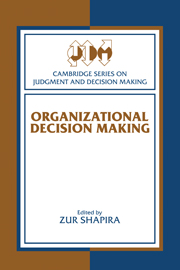Book contents
- Frontmatter
- Contents
- Series preface
- List of contributors
- Editor's preface
- Part I Introduction
- Part II Information processing and attention allocation
- Part III Preference processing
- Part IV Decision processes
- Part V Alternative approaches
- 13 Naturalistic decision making and the new organizational context
- 14 Telling decisions: The role of narrative in organizational decision making
- 15 Bounded rationality, indeterminacy, and the managerial theory of the firm
- 16 The scarecrow's search: A cognitive psychologist's perspective on organizational decision making
- Name index
- Subject index
13 - Naturalistic decision making and the new organizational context
Published online by Cambridge University Press: 06 August 2010
- Frontmatter
- Contents
- Series preface
- List of contributors
- Editor's preface
- Part I Introduction
- Part II Information processing and attention allocation
- Part III Preference processing
- Part IV Decision processes
- Part V Alternative approaches
- 13 Naturalistic decision making and the new organizational context
- 14 Telling decisions: The role of narrative in organizational decision making
- 15 Bounded rationality, indeterminacy, and the managerial theory of the firm
- 16 The scarecrow's search: A cognitive psychologist's perspective on organizational decision making
- Name index
- Subject index
Summary
Introduction
Naturalistic decision making (NDM) is gaining some currency as a label for a loose grouping of nonstandard models of individual decision making. These models, although very different from one another, all address the descriptive inadequacies of the classical, subjective expected utility (SEU) view of economic rationality and its closer descendants, such as prospect theory (Kahneman & Tversky, 1979) and generalized utility theory (Camerer, 1992). Continuing work within the SEU tradition is essentially conservative, aiming to preserve the important achievements of the theory while adding modifications to accommodate the most embarrassing empirical violations. NDM theories, in contrast, are generally more radical. They conceive of decision making in ways quite different from SEU theory.
The source of this radicalism is simple: SEU theory appears to offer little descriptive purchase on a broad range of everyday decision phenomena. Decisions are frequently made under time pressure, precluding the sorts of careful balancing and computation SEU implies. Decisions are made in dynamic, uncertain, or ambiguous environments, making the notion of an “expectation” problematic. Goals and preferences may be unclear, making notions of stable, known utilities hard to apply. There may be multiple participants, with shifting roles as collaborators, advisors, or opponents. (See Orasanu and Connolly, 1993, for a sample of this critical literature.) Because observations of organizational contexts suggest that these complicating factors are often present, NDM takes organizational decision making as a primary domain of application.
- Type
- Chapter
- Information
- Organizational Decision Making , pp. 285 - 303Publisher: Cambridge University PressPrint publication year: 1996
- 4
- Cited by



